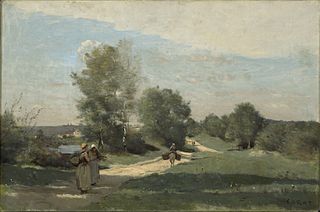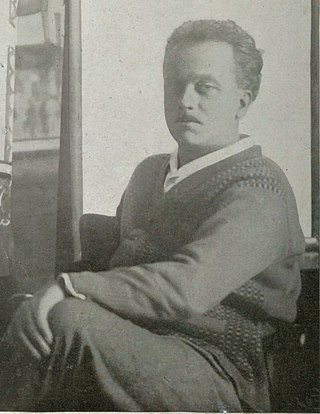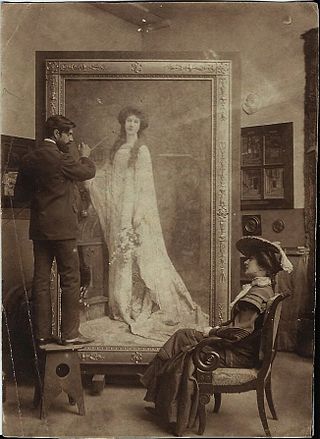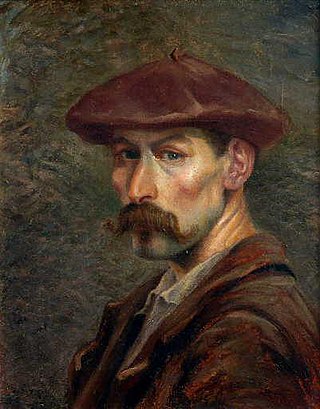This article relies largely or entirely on a single source .(June 2020) |

Paul Tavernier (31 January 1852, Paris - 1943, Fontainebleau) was a French painter who specialized in hunting scenes and animals.
This article relies largely or entirely on a single source .(June 2020) |

Paul Tavernier (31 January 1852, Paris - 1943, Fontainebleau) was a French painter who specialized in hunting scenes and animals.

He was a student of Alexandre Cabanel, Adolphe Yvon and Gustave Guillaumet, who advised him to visit North Africa as a means of lightening his palette. He had his debut at the Salon in 1876. [1] Three years later, he began painting en plein aire near Barbizon, and came under the influence of the painters who had made up the art colony there.
In 1883, he became a member of the Société des artistes français and was awarded a third-class medal for works he had created during his stay in Africa. He would continue to send paintings to their exhibits until 1937. [1]
He was not only an admirer of the area where he chose to paint, he also became involved in the municipal affairs of Fontainebleau, participating in projects to develop the city and preserve its environment. Among other things, he helped to create the Golf de Fontainebleau and decorated its club house. Later, he created murals for the municipal theatre, depicting King Louis XV on a hunt. [1]
In 1901, as an amateur horseman, he was one of the founders of the local racing society; helping to renew the Hippodrome De La Solle , which had been built in 1862. [1]
He received bronze medal at the Exposition Universelle of 1900 and, in 1905, a second-class medal at an exhibition of the École des Paysagistes.
He was last heard from in 1943, during World War II. A street in Fontainebleau bears his name.

Palace of Fontainebleau, located 55 kilometers southeast of the center of Paris, in the commune of Fontainebleau, is one of the largest French royal châteaux. It served as a hunting lodge and summer residence for many of the French monarchs, including Louis VII, Francis I, Henry II, Louis-Philippe, Napoleon I, and Napoleon III. Though the monarchs only resided there for a few months of the year, they gradually transformed it into a genuine palace, filled with art and decoration. It became a national museum in 1927 and was designated a UNESCO World Heritage Site in 1981 for its unique architecture and historical importance.

Jean-Baptiste-Camille Corot, or simply Camille Corot, was a French landscape and portrait painter as well as a printmaker in etching. A pivotal figure in landscape painting, his vast output simultaneously referenced the Neo-Classical tradition and anticipated the plein-air innovations of Impressionism.

Alfred Sisley was an Impressionist landscape painter who was born and spent most of his life in France, but retained British citizenship. He was the most consistent of the Impressionists in his dedication to painting landscape en plein air. He deviated into figure painting only rarely and, unlike Renoir and Pissarro, he found that Impressionism fulfilled his artistic needs.

The Barbizon school of painters were part of an art movement toward Realism in art, which arose in the context of the dominant Romantic Movement of the time. The Barbizon school was active roughly from 1830 through 1870. It takes its name from the village of Barbizon, France, on the edge of the Forest of Fontainebleau, where many of the artists gathered. Most of their works were landscape painting, but several of them also painted landscapes with farmworkers, and genre scenes of village life. Some of the most prominent features of this school are its tonal qualities, color, loose brushwork, and softness of form.

Alexandre Cabanel was a French painter. He painted historical, classical and religious subjects in the academic style. He was also well known as a portrait painter. He was Napoleon III's preferred painter and, with Gérôme and Meissonier, was one of "the three most successful artists of the Second Empire."

Maximilien Luce was a prolific French Neo-impressionist artist, known for his paintings, graphic art, and his anarchist activism. Starting as a wood-engraver, he then concentrated on painting, first as an Impressionist, then as a Pointillist, and finally returning to Impressionism.
Charles Paul Landon was a French painter and popular writer on art and artists.

Raoul Dufy was a French painter associated with the Fauvist movement. He gained recognition for his vibrant and decorative style, which became popular in various forms, such as textile designs, and public building decorations. Dufy is most remembered for his artwork depicting outdoor social gatherings. In addition to painting, he was skilled in various other fields, including drawing, printmaking, book illustration, scenic design, furniture design, and planning public spaces.

Jean-Louis-Ernest Meissonier was a French academic painter and sculptor. He became famous for his depictions of Napoleon and his military sieges and manoeuvres in paintings acclaimed both for the artist's mastery of fine detail and his assiduous craftsmanship. The English art critic John Ruskin examined his work at length under a magnifying glass, "marvelling at Meissonier's manual dexterity and eye for fascinating minutiae." Meissonier enjoyed great success in his lifetime, becoming, with Gérôme and Cabanel, one of "the three most successful artists of the Second Empire."

Jean Lurçat was a French artist noted for his role in the revival of contemporary tapestry.

Toussaint Dubreuil was a French painter, associated with the second School of Fontainebleau.

Henri-Jean Guillaume "Henri" Martin was a French painter. Elected to the Académie des Beaux-Arts in 1917, he has been described as a prolific master whose work has touches of melancholy, dreaminess and mystery.

Antoine Caron (1521–1599) was a French master glassmaker, illustrator, Northern Mannerist painter and a product of the School of Fontainebleau.
Antonio Alice was an Argentine portrait painter. He was awarded the Prix de Rome in 1904.

Jules Marie Auguste Leroux was a French painter and illustrator.

Charles Zacharie Landelle was a French painter who specialized in portraits. He is best known for his Orientalist works.

Léo Gausson was a French landscape painter in the Neo-impressionist and Synthetic styles. He was also a printmaker and sculptor.

Edmond Antoine Anne Tapissier was a French painter, illustrator, lithographer and tapestry designer.

Eugène Henri Alexandre Chigot was a post impressionist French painter. A pupil of his father, the military painter Alphonse Chigot, in 1881 he entered the internationally renowned École des Beaux-Arts in Paris where he was exposed to the ideas of the realist movement of the Barbizon School and to Impressionism. He settled in Étaples in the Pas-de-Calais in an artists’ colony, later returning to Paris where he became a founder of the Salon d’Automne. An official military painter he painted a series of canvases in Calais and Nieuwpoort recording the destruction caused by the First World War. Chigot's reputation was built on his maritime and landscape paintings that arose from his affinity to Flanders and the Pas-de-Calais. He recorded the lives of the people of Flanders placing them within a landscape of soft opalescent light. Later his paintings show traces of expressionism and a more vibrant pallette. He was also a skilled nocturne painter who travelled extensively within France, Italy and Spain.

Armand-Théophile Cassagne was a French painter, watercolorist, lithographer, and writer; associated with the Barbizon School.